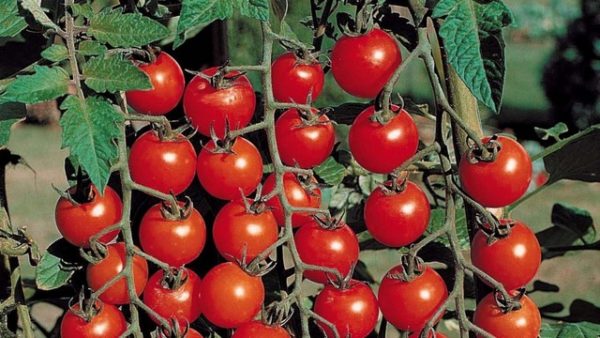
The use of tomatoes is very diverse - in medicine, in cooking and even cosmetology. For each of this application, you need your own fruit, which has a certain content of trace elements and vitamins. The variety "Thumbelina" is a variety of miniature cherry tomatoes that are beloved by cooks.
This is a very unpretentious vegetable that can be grown in greenhouse conditions or on the windowsill of the balcony. It is necessary to properly care for the plant, then it will bear delicious fruits of high productivity.
Content
Description of the variety and its characteristics
Thumbelina is a tall tomato fruit plant that is intended to be grown under film coatings or in glass-protected rooms. The variety "Thumbelina" is indeterminate.
This species can reach a height of 1.5 meters, so you need to carry out stepsoning and garter stems at this height. The tomato has the best yield when growing with 2-3 stems, then up to 15 fruits can be tied on each brush.
The plant begins to bear fruit already after 3 months from the moment of planting seeds. Ripe fruits "Thumbelina" with a good rich taste, an average of 15-20 g of red color, dense, smooth to the touch, rounded.
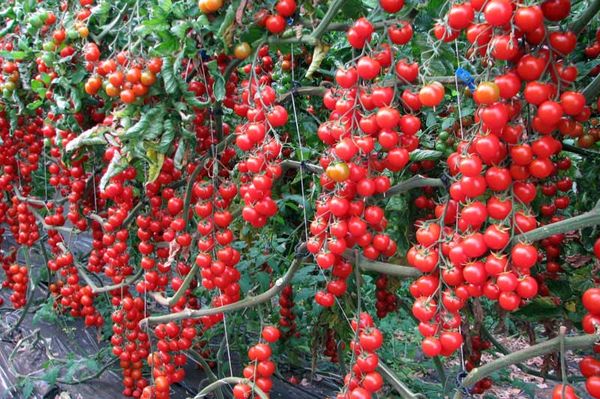
With proper care, you can achieve yields from one square meter of plantations to 4.7 kilograms.
Among the main advantages of this variety, one can distinguish excellent dessert taste and high resistance to the most common diseases of plants of the nightshade family. They are used for canning, preparing various dishes and salads, and are also great for eating raw.
Advantages and disadvantages of the grade "Thumbelina"
Each plant requires a certain microclimate and care, as well as soil and fertilizer. Among the main advantages of the variety are:
- bunch ripening of all fruits in a very short time period, while it is possible to collect fruits from one bush almost on the same day;
- resistance to rot and powdery mildew, as well as to many other nightshade diseases;
- self-pollination ability, which for closed balconies and greenhouses is an important component of plant productivity.
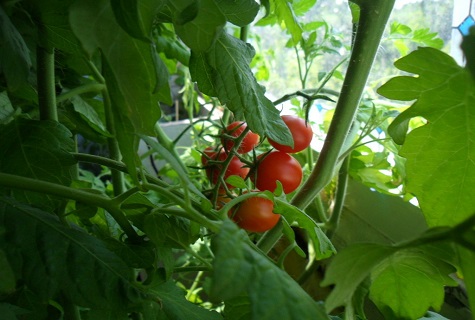
Among the disadvantages that can significantly reduce productivity, and even completely cause the death of the plant, the following are distinguished:
- High sensitivity to temperature fluctuations. These greenhouse tomatoes require a closed space without drafts.
- They are very sensitive to the regime of irrigation, do not tolerate stagnant water.
- They require spacious containers, since the roots grow strongly and, if they are not sufficiently free, can lead to wilting of the plant.
Planting tomato seeds "Thumbelina"
The seeds of this variety are sown in a special soil mixture, which you can prepare yourself at home. First of all, you need to take mineral fertilizers, sand, peat or humus and mix with garden soil.To disinfect, it is enough to heat the oven and hold the prepared mixture there.
Before sowing, you need to sanitize the seeds. This is done by immersing the seeds in a solution of potassium permanganate for 3-4 minutes. After this procedure, the grains must be washed and left to germinate for 2-3 days in a wet tissue. The fabric with seeds should be kept warm and its moisture should be monitored, it should not be allowed to dry. Grains are ready for planting as soon as they germinate.
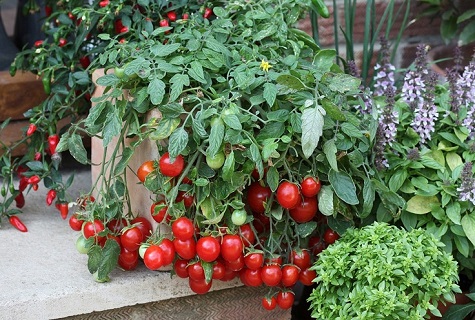
Containers with soil must be prepared in advance, for this they are cleaned and covered with a drainage layer, on top of which the prepared or acquired special soil is poured. The earth is slightly moistened, a small groove is made about 1 cm deep and the seeds of the Thumbelina are laid out and sprinkled with a layer of soil. A minimum distance of 2 cm between adjacent shoots must be observed. For a period of 5-6 days, the container should be covered with film or glass and put in a warm place with a temperature of 20-25 ° C. As a rule, after this time the first sunrises may appear.
Tomatoes are very demanding on lighting, therefore, for subsequent rapid growth, you should install a phytolamp or just organize enhanced lighting.
Diving should be carried out immediately, as soon as the plants have developed two or three leaflets. Their roots grow very quickly, which can lead to tangling of neighboring plants in a common container, and belated diving only injures the sprout. Later, diving and transplanting into separate containers can be done if you plant seedlings farther apart from each other or thin out the sunrises very carefully during a normal landing.
"Thumbelina" is seated in separate 200-250 ml cups, prepared in advance. You can use pots measuring 8x8 cm. You should not take very spacious pots. There is a possibility of the appearance of fungal soil that can infect the plant. Usually it appears in unoccupied areas.
Pinching the central root or not remains an open question. This can somewhat inhibit plant growth, but it stimulates a more branched rhizome. When diving, often a small root is nevertheless plucked from the central root.
Features seedlings care
After planting the sprouts in separate containers, it is recommended to place the pots in a dark place for 2-3 days. After such manipulation, the seedlings are placed in conditions with good clarification. After another one and a half weeks, seedlings begin to slowly accustom to fresh air.
The first top dressing is introduced approximately 1.5 weeks after the dive. Fertilizers can be complex or prepared independently.

To do this, you will need:
- potassium sulfate - 12 g;
- superphosphate - 35 g;
- urea - 4 g.
Dissolve all components in 10 liters of cold clean water. Fertilizing and watering is desirable to combine. Watering is carried out as it dries. The water balance of the soil should not be allowed to move in any direction.
Features of tomato care
The period of plant transfer to the greenhouse is recommended to be selected approximately 40-50 days after germination. Most often this falls in mid-May. Prepare the soil in the greenhouse in advance. Fertilizing the soil after growing tomatoes on it should be carried out in the fall, since this plant greatly depletes it.
Reinforced fertilizer should be applied when planting the plant in the soil, which has already grown several generations of nightshade.It is necessary to plant plants at a distance of 0.6-0.7 m between the bushes near a pre-installed support. Stems should be tied when the Thumbelina reaches 30 cm.
The main manipulations when caring for a plant:
- soil loosening;
- removal of stepsons;
- tying stems.
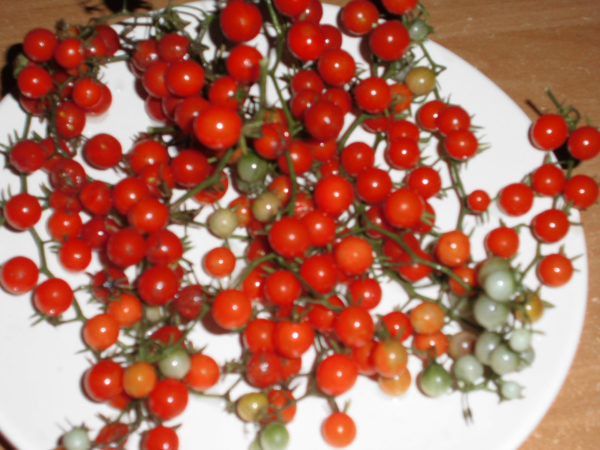
The need for mulching the soil will prompt its drying. Periods for fertilizing:
- bloom;
- ovary formation;
- fetal formation.
Inorganic fertilizers such as Mortar, Magnesium Sulphate, Kemira Universal 2 and organic - humus or peat can be used.
Reviews gardeners
Ekaterina Nikolaevna, 65 years old. Moscow region:
“At first I decided to plant for the sake of interest in order to see what kind of wonderful tomatoes they are. She left the bushes with one stalk. I didn’t dare to make 2-3 stalks; on the balcony you won’t accelerate too much. It turned out that the brushes with ripened fruits look very elegant, like beads. The fruits themselves are 2-3 cm in size, totaling 17 pcs. Tomatoes were tasty and sweet. I didn’t really like it, but relatives and children tried it. "Harvested even when the children have already gone to school, bear fruit for a long time."
Tatyana, 39 years old. Rostov-on-Don:
“I became interested in this variety because the seed store recommended it as a resistant variety to all kinds of diseases and other“ tomato ”troubles. Planted several bushes. Let all the tomatoes grow in one stalk. They came out lush and with the same tomatoes. Very tasty and neat. It is bad that this is a hybrid plant and it is impossible to collect seeds next year. I’ll have to buy them again. ”
Ivan Matveevich, 67 years old. Tver:
“I liked the variety in the picture. I really hoped that it would be exactly the same with me. I did everything according to the instructions, but overfilled seedlings or gave her insufficient lighting, I don’t know. Some sprouts planted, and the remaining 3 failed. I went out and gathered a very good harvest. Next time I’ll also try to get the promised 4.7 kg per square meter. ”
Thumbelina tomatoes are an excellent alternative to the usual large varieties of this plant. These small fruits have a rich taste. On the table, neat fruits look much more elegant in fresh or canned form.




 Low-growing tomatoes, without pinching: 5 of the most delicious varieties
Low-growing tomatoes, without pinching: 5 of the most delicious varieties Why tomato seedlings grow poorly
Why tomato seedlings grow poorly We grow a tomato in a shell
We grow a tomato in a shell Growing tomatoes without watering according to the method of Kazarin
Growing tomatoes without watering according to the method of Kazarin